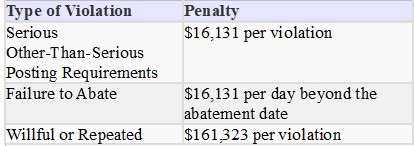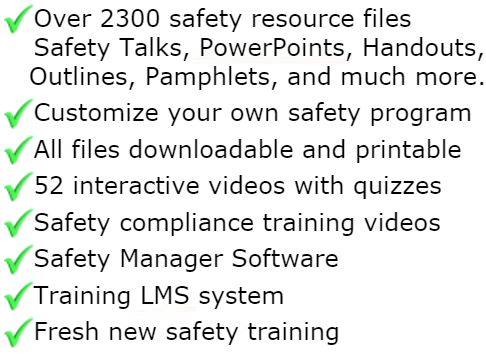
Biological Agent & Diseases
A biological agent is an infectious disease or toxin that can be used in bioterrorism or biological warfare or can be encountered in workplace setting.
There are more than 1200 different kinds of biological agents.
Biological agents include bacteria, viruses, fungi, other microorganisms and associated toxins. They have the ability to adversely affect human health in a variety of ways, ranging from relatively mild, allergic reactions to serious medical conditions, even death. These organisms are widespread in the natural environment; they are found in water, soil, plants, and animals.
Because many microbes reproduce rapidly and require minimal resources for survival, they are a potential danger in a wide variety of occupational settings.
Biological Agent Basics
Anthrax. Anthrax is an acute infectious disease caused by a spore-forming bacterium called Bacillus anthracis. It is generally acquired following contact with anthrax-infected animals or anthrax-contaminated animal products.
Avian Flu. Avian influenza is a highly contagious disease of birds which is currently epidemic amongst poultry in Asia. Despite the uncertainties, poultry experts agree that immediate culling of infected and exposed birds is the first line of defense for both the protection of human health and the reduction of further losses in the agricultural sector.
Bloodborne Pathogens and Needlestick Prevention. 5.6 million workers in the health care industry and related occupations are at risk of occupational exposure to bloodborne pathogens, including human immunodeficiency virus (HIV), hepatitis B virus (HBV), hepatitis C virus (HCV), and others.
Botulism. Cases of botulism are usually associated with consumption of preserved foods. However, botulinum toxins are currently among the most common compounds explored by terrorists for use as biological weapons.
Foodborne Disease. Foodborne illnesses are caused by viruses, bacteria, parasites, toxins, metals, and prions (microscopic protein particles). Symptoms range from mild gastroenteritis to life-threatening neurologic, hepatic, and renal syndromes.
Hantavirus. Hantaviruses are transmitted to humans from the dried droppings, urine, or saliva of mice and rats. Animal laboratory workers and persons working in infested buildings are at increased risk to this disease.
Legionnaires' Disease. Legionnaires' disease is a bacterial disease commonly associated with water-based aerosols. It is often the result of poorly maintained air conditioning cooling towers and potable water systems.
Molds and Fungi. Molds and fungi produce and release millions of spores small enough to be air-, water-, or insect-borne which may have negative effects on human health including allergic reactions, asthma, and other respiratory problems.
Plague. The World Health Organization reports 1,000 to 3,000 cases of plague every year. A bioterrorist release of plague could result in a rapid spread of the pneumonic form of the disease, which could have devastating consequences.
Ricin. Ricin is one of the most toxic and easily produced plant toxins. It has been used in the past as a terrorism weapon and remains a serious threat.
Severe Acute Respiratory Syndrome (SARS). Severe acute respiratory syndrome (SARS) is an emerging, sometimes fatal, respiratory illness. According to the Centers for Disease Control and Prevention (CDC), the most recent human cases of SARS were reported in China in April 2004 and there is currently no known transmission anywhere in the world.
Smallpox. Smallpox is a highly contagious disease unique to humans. It is estimated that no more than 20 percent of the population has any immunity from previous vaccination.
Tularemia. Tularemia is also known as "rabbit fever" or "deer fly fever" and is extremely infectious. Relatively few bacteria are required to cause the disease, which is why it is an attractive weapon for use in bioterrorism.
Viral Hemorrhagic Fevers (VHFs). Along with smallpox, anthrax, plague, botulism, and tularemia, hemorrhagic fever viruses are among the six agents identified by the Centers for Disease Control and Prevention (CDC) as the most likely to be used as biological weapons. Many VHFs can cause severe, life-threatening disease with high fatality rates.
All materials in the members area for this topic index

GET INSTANT ACCESS
to THE MEMBERS LIBRARY
Safety materials created by safety professionals.
Access to the Safety Manager software.
Wide variety of safety videos and courses.
**Brand New** Safety Training Management System
Pre-Made Safety Materials Ready For Use
Created by experienced safety professionals & risk consultants. Saving you time, money, and risk of injuries.
95% of the work already done.
Below are the maximum penalty amounts, with the annual adjustment for inflation, that may be assessed after Jan. 15, 2024. (See OSHA Memo, Jan. 8, 2024).

**New OSHA HEAT 90 DAY**
>>Download Free HERE<<
**New 2024 OSHA 300 Form**
>>Download Free HERE<<
**Brand New**
Free with full membership subscription
Training LMS System
Ask The Safety Consultant
Safety Equipment Deal Finder

“SafetyInfo.com is the first go-to website for safety professionals and companies to use in establishing a solid safety program"
-Mike McKenzie, Certified Safety & Health Manager (CSHM), McSafety Solutions™
Note: You must have a full subscription to the Safety Library in order to use this material. Any use outside of your organization, for resell, or without an active membership is strictly prohibited and may result in prosecution under copyright infringement laws. Please contact us first, if you would be interested in reselling or using our materials for reproduction.
Inside the Members Library
Topic Index
Accident Prevention
Air Quality
Asbestos
Bloodborne Pathogens
Boilers
Chemical Safety
Compressed Gas
Confined Space
Construction
Construction Worksite
Cranes & Slings
Driver / Fleet Safety
Drug Free Workplace
Electrical
Emergency Management
Engineering Safety
Environmental
Equipment
Ergonomics
Fall Protection
Fire Safety & Prevention
First Aid
Flammable Materials
Forklifts
Hazard Communication
Hazardous Materials
Hearing Protection
Heat Stress
Hot Work
Housekeeping
Job Safety Analysis
Laboratory
Ladders
Lead
Lockout-Tagout
Machinery & Equipment
Material Handling
MSDS (SDS)
Medical & First Aid
Occupational Health
Office Safety
Off the Job Safety
Personal Protection
Process Safety
Record Keeping
Respiratory Protection
Silica Safety
Rules & Policies
Signs & Labels
Slips, Trips & Fall
Training
Terrorism Programs
Tool Safety
Vehicle & Driver
Violence Programs
Welding & Hot Work
Training Videos
Library Index
Training Materials
Videos/Courses
Talks
Articles
PowerPoint
Handouts
Training Overheads
Quizzes
Supervisor Briefs
Management Briefs
Safety Sessions
2 Minute OSHA Safety Talks
Pamphlets
First Aid Training
Supervisor Training
Hazardous Materials
Bomb Threat
Crossword Puzzles
Biological Agents
Forms & Documents
Forms
Checklists
Audit Guides
Inspections Guides
Signs & Labels
Environmental Audit Guides
Recordkeeping - OSHA 300
Sign & Label Maker
Safety Management Resources
Safety Manuals/Written Programs
Ergonomic Programs
Emergency Plans
Process Safety Management
Construction Safety
Occupational Health
Environmental
Topic Sheets
DOT Fleet-Driver
Hazardous Materials
Chemical Safety
Drug Free Workplace
Terrorism Programs
Development Guides
Safety Manager Software
Safety References & Graphics
Technical Safety Information
Posters
Topic & Fact Sheets
Development Information
Job Specific Safety Rules
Terrorism
Calculators
Safety Comic Strips
New Safety Training System
Schedule and train your employees with our materials. Add unlimited amount of employees. Record all progress and issue certificates. For group and individual training sessions.

